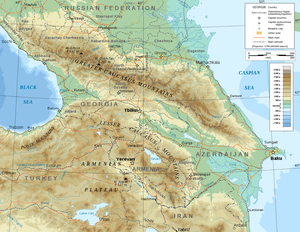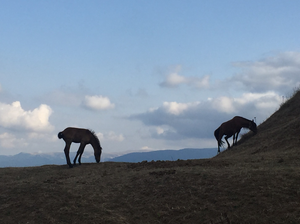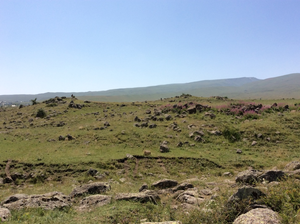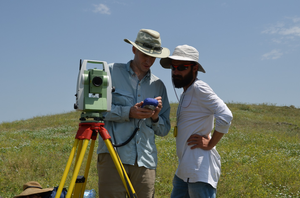ISAW Hosts South Caucasus Colloquium
The countries of the South Caucasus – Armenia, Azerbaijan and Georgia -- are areas of growing interest for study by scholars in the West. Once isolated behind the Iron Curtain so that only Soviet scholars worked there, the location of the South Caucasus on the northern edge of the Ancient Near East has encouraged study of its past by experts in many fields whose work may first have been grounded in areas further south (like much work by Western Europeans even before the formation of the Soviet Union). Today the South Caucasus offers students in the historical, archeological and art historical fields opportunities for pioneering work in countries with rich traditions still unfamiliar to many in the west.
It is because of the growing interest in the study of this area that the South Caucasus Colloquium has been held at ISAW and is one of several South Caucasus focused events over the last years. Among them, In April 2014 was the symposium “Borders in the Archaeology of Pre-Classical Anatolia and the South Caucasus (BA-IA)” organized by ISAW Professor Lorenzo D’Alfonso and myself.

And last spring, May 2016, a two-day program “Progress, Problems and Possibilities of GIS in the South Caucasus: An International Workshop” focused on the challenges and benefits of using Geographic Information Systems in the mountainous region.
Bourrichon with English translations, additions, and corrections by Ketone16 (partly following Yuri Koryakov)
Professor Robert Hoyland excavates in Azerbaijan and Visiting Research Scholar Alan Greene works in Armenia. The South Caucasus was a component of the fall 2016 Seminar led by Professors Rod Campbell and Lorenzo D’Alfonso: The Ancient World at the End of the Bronze Age (c. 1250-1050 BCE).
On December 10, twenty-eight archaeologists, historians, and art historians gathered to discuss their current projects and to share expertise on both the subject matter and special challenges of working in the South Caucasus. Among them were five ISAW graduate students, two ISAW professors, one ISAW Visiting Research Scholar, and myself, an ISAW Research Associate. Other attendees came from NYU Washington Square, Cornell, CUNY Graduate Center, Johns Hopkins University, Manhattaville College, Harvard University, the University of Pennsylvania, William Patterson University, Widener University, Bryn Athyn College, Koç University and the Metropolitan Museum of Art.
Participants shared current research and projects in and about Armenia, Azerbaijan, and Georgia spanning time from the Paleolithic through Medieval times. Archaeological reports included news of the Lerik in Antiquity Archaeological project (LAAP), a new project in Azerbaijan, co-directed by Susannah Fishman, University of Pennsylvania, that focuses on Achaemenid times through the Late Antique, in a region between the Caspian Sea and the Iranian border, in a rugged landscape (see photo).

In survey and test trenches, they have uncovered evidence of structures that are contemporary with a nearby cemetery being excavated by their Azerbaijani colleagues.
Landscape in the region of Lerik, Azerbaijan. Photo by Selin Nugent
ISAW Visiting Research Scholar Alan Greene co-directs the Kasakh Valley Archaeological Survey (KVAS) in Armenia. KVAS is performing pedestrian and aerial survey across 200 sq km of the upper river valley in order to establish the settlement and burial patterns from the Paleolithic through recent times. Evidence retrieved and recorded this past summer included, on the early side, a beautiful black obsidian Acheulian hand axe and on the later end remnants of Bronze Age occupation sites and Soviet period land transformations.
Nat Erb-Satullo, Fellow, Department of Anthropology, Harvard University, directs a field project in Eastern Georgia, the Archaeological Research in Kvemo Kartli (ARKK) Project, an excavation and survey project in a region with metal ore sources, the use of which is a focus of the project.

The survey has identifed a variety of settlement sites, including Kavakh Tepe, a Late Bronze/Early Iron Age fortress. This site and others found by the ARKK team share characteristics of fortresses identified by Project ArAGATS (see above), a graphic illustration that the modern borders of the countries of the South Caucasus do not correspond to prehistoric cultural horizons.
Archaeologists from Project ArAGATS' 2016 Kasakh Valley Archaeological Survey (KVAS) traverse one of the many volcanic ridges in the eastern foothills of Mt. Aragats. The survey team can be made out at left, center, and right at the top of the ridge.” Photo courtesy of Alan Greene.
I can’t include in this short post summaries of all of the presentations made, but they ranged from archaeological science (paleoclimate reconstruction in Armenia and DNA studies in Georgia) to the historical (Sasanian Caucasia) and the art historical (a forthcoming exhibition about Armenia at the Metropolitan Museum of Art that will open in September 2018).

All presentations stimulated active discussion and exchange, furthering everyone’s research goals -- the ultimate benefit of the opportunity to gather at ISAW for the Colloquium.
Nat Erb-Satullo (left) and Georgian colleague Dmitri Jachvliani (right) mapping the newly discovered fortress site of Kavakh Tepe with a total station. Photo courtesy of Nat Erb-Satullo.